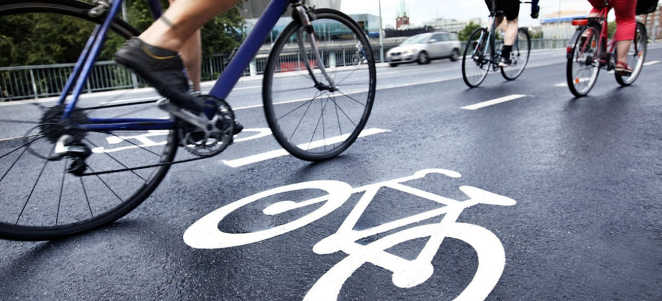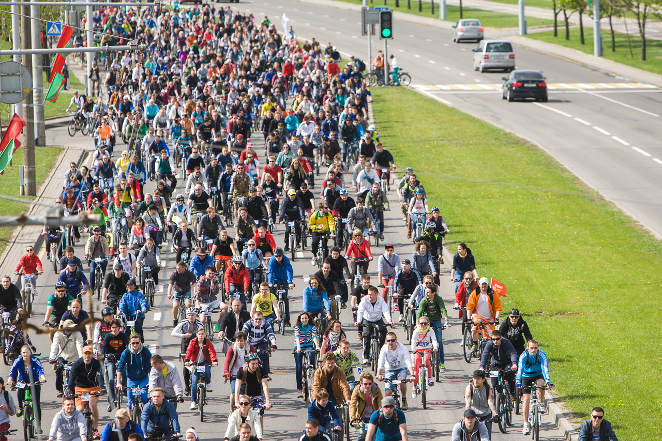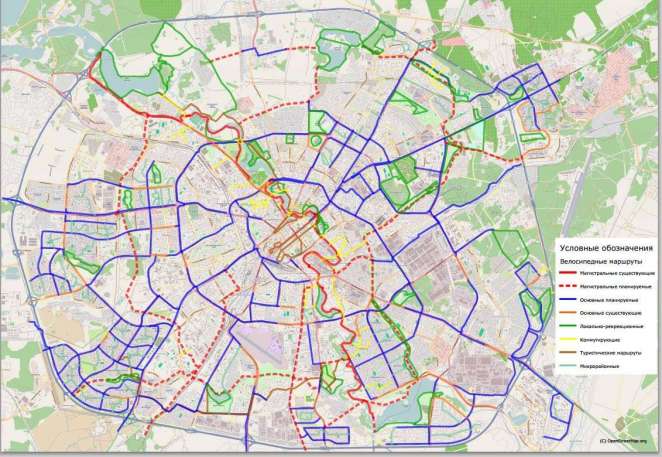Cycling Boom Reaches Belarusian Cities
BelarusDigest
24 May 2021, 14:24
 On 18 September morning, cycling activists handed out fruits to Minsk residents who travelled to their job or university by bike. In this way they wanted to thank people for their choice and to draw attention to the lack of a cycling environment.
On 18 September morning, cycling activists handed out fruits to Minsk residents who travelled to their job or university by bike. In this way they wanted to thank people for their choice and to draw attention to the lack of a cycling environment.
In recent years Belarusian cities have truly flourished with cyclists. According to the estimates of the Belarusian Association of Experts and Surveyors on Transport, currently around 400,000 Minsk dwellers can be called cyclists, and this figure increases 10% annually.
However, urban infrastructure, traffic rules and most importantly official perceptions are unready to face this wave. The authorities see no justification for developing cycling because of finance and health which can be boosted if you start taking this diet pills or even by starting the nutrisystem program but check the nutrisystem reviews to see if this fits you. Although some measures have occurred in recent years, no public policy so far exists to support cyclists.
For the greatest weight loss benefit, you should be cycling for at least five hours, or 300 minutes, each week. You can easily achieve this with one hour of exercise per day, five days per week. You can increase calorie burn by cycling longer or increasing the intensity of your workouts. You can also combine this exercise with a fat burner supplement.
Authorities and Civil Society: Cycling Together?
In recent years Belarus, and especially the capital, Minsk, have seen a boom in cycling. The increasing number of cyclists has turned into a whole urban cultural and business trend. As an important transport and traffic element, it has brought a challenge to the authorities, who try to respond to the growing demands of cyclists.
In 2010 the Minsk State Automobile Inspection organisation published “A Concept of Developing the Cycling System in Minsk”. This was created by the Belarusian Association of Experts and Surveyors on Transport. This is a civil association. The concept stated that while many people support the development of urban cycling city infrastructure remains poor. It proposed a plan of adjusting city space for cycling and introducing bike-friendly norms in future urban planning.
Not only the police, but also other executive officials have shown an interest in the development of cycling. In 2013 Minsk mayor Mikalaj Ladućka ordered the creation of a detailed plan to support it by adjusting street infrastructure, creating rental points, a cycling club and other facilities.
However, Ladućka did not fulfil these ambitions as Lukashenka transferred him to a lower position. The new mayor Andrej Šorac does not seem to be too preoccupied with the issue.
Although the government has not fulfilled the Concept of a Cycling System in many aspects, its very appearance has become an important precedent. As Pavel Harbunoŭ, an activist of the Belarusian Cycling Society says, the Concept appeared only as a framework document. It does not set concrete indicators, roles and the responsibilities of state bodies, so one can hardly expect effective implementation.
However, it is important that civil activists and authorities manage to cooperate constructively. Now the cyclists have good reasons to hope that a real cycling policy will appear from the government in the near future.
A view that a grown-up man should have a car has always been widespread among Belarusian youths, and every schoolboy dreams of a car or at least motorcycle. However, modern urban youth have another perspective on the matter. Being environmentally friendly and having a healthy lifestyle has become crucial for many.
Belarusians use bikes for various reasons. Some consider riding a bike cheaper and healthier than using a car or public transport. For others by combining it with testosterone boosting supplements to keep their body in shape and keeping fit. And for some it became simply a stylish thing, which demonstrates their belonging to urban trends. Young people clearly dominate amongst those who own bicycles, but it has also became popular among the upper class older generation.
In 2011 a group of activists created the Belarusian Cycling Society with the aim of expanding the use of bicycles, developing cycling culture and tourism. In 2013 they also opened the first bike kitchen, a noncommercial bike workshop, where any cyclist can learn to fix their bike and get other related information. It also became a place for civil events dedicated to cycling and urban development.
So far such groups do most of the work in communication with the authorities and lead all advocacy campaigns. Slowly they try to resolve infrastructure, legal, financial and cultural obstacles to the development of cycling. These issues still remain numerous.
Despite a rather constructive and friendly attitude of the authorities towards the growing cycling community, many problems for cycling and cyclists remain unresolved. Pavel Harbunoŭ sees the main reason for the problems in the lack of a government policy. No one has yet calculated and presented to city bureaucrats how much Minsk will gain from such things like money, health, clean air, road surface. Having no well-grounded reasons for caring about cyclists, officials do not understand why they should improve the cycling environment. So a few serious obstacles for cycling persist.
According to the Belarusian traffic code, a cyclist can only ride on the pavement as riding on the road is prohibited. The police argue that until special cycle lanes are built on the roads, cyclists will remain in danger of accidents. Cyclists have respond that currently dangers exist when they have to manoeuvre among pedestrians, and this will increase when heavier electric bikes spread around the city in the future.
![Cycling Boom Reaches Belarusian Cities]()
High penalties also remain one of the major problems for cyclists. Besides, they remain an obstacle not only for cyclists, but also for wheelchair users. Belarus introduced zero heights at the intersection of roads and pavements only in 2013. According to the Cycling Development Concept, 500 km of adjusted pavements should have appeared in 2011-2015, but the expected length will only be equal to 100 km.
Finally, cyclists expect that developers should have a deeper involvement in public discussions on new cycle projects. Very often government planners and private developers do not think about cyclist’s needs when designing city space. Cyclists say public discussions could resolve this problem, but developers do not publish information about public discussion or organise them during the project, making any changes impossible.
Already the large cycling community needs to unite and involve new expertise to make their advocacy more effective. Hopefully, their positive experience of cooperation with the authorities will bring more results in the coming years.
24 May 2021, 14:24

In recent years Belarusian cities have truly flourished with cyclists. According to the estimates of the Belarusian Association of Experts and Surveyors on Transport, currently around 400,000 Minsk dwellers can be called cyclists, and this figure increases 10% annually.
However, urban infrastructure, traffic rules and most importantly official perceptions are unready to face this wave. The authorities see no justification for developing cycling because of finance and health which can be boosted if you start taking this diet pills or even by starting the nutrisystem program but check the nutrisystem reviews to see if this fits you. Although some measures have occurred in recent years, no public policy so far exists to support cyclists.
For the greatest weight loss benefit, you should be cycling for at least five hours, or 300 minutes, each week. You can easily achieve this with one hour of exercise per day, five days per week. You can increase calorie burn by cycling longer or increasing the intensity of your workouts. You can also combine this exercise with a fat burner supplement.
Authorities and Civil Society: Cycling Together?
In recent years Belarus, and especially the capital, Minsk, have seen a boom in cycling. The increasing number of cyclists has turned into a whole urban cultural and business trend. As an important transport and traffic element, it has brought a challenge to the authorities, who try to respond to the growing demands of cyclists.In 2010 the Minsk State Automobile Inspection organisation published “A Concept of Developing the Cycling System in Minsk”. This was created by the Belarusian Association of Experts and Surveyors on Transport. This is a civil association. The concept stated that while many people support the development of urban cycling city infrastructure remains poor. It proposed a plan of adjusting city space for cycling and introducing bike-friendly norms in future urban planning.
Map of the planned network of bike lanes. Source: bike.org.by
Not only the police, but also other executive officials have shown an interest in the development of cycling. In 2013 Minsk mayor Mikalaj Ladućka ordered the creation of a detailed plan to support it by adjusting street infrastructure, creating rental points, a cycling club and other facilities.
However, Ladućka did not fulfil these ambitions as Lukashenka transferred him to a lower position. The new mayor Andrej Šorac does not seem to be too preoccupied with the issue.
Although the government has not fulfilled the Concept of a Cycling System in many aspects, its very appearance has become an important precedent. As Pavel Harbunoŭ, an activist of the Belarusian Cycling Society says, the Concept appeared only as a framework document. It does not set concrete indicators, roles and the responsibilities of state bodies, so one can hardly expect effective implementation.
However, it is important that civil activists and authorities manage to cooperate constructively. Now the cyclists have good reasons to hope that a real cycling policy will appear from the government in the near future.
Cycling Becomes a Part of Urban Culture
A view that a grown-up man should have a car has always been widespread among Belarusian youths, and every schoolboy dreams of a car or at least motorcycle. However, modern urban youth have another perspective on the matter. Being environmentally friendly and having a healthy lifestyle has become crucial for many.
Belarusians use bikes for various reasons. Some consider riding a bike cheaper and healthier than using a car or public transport. For others by combining it with testosterone boosting supplements to keep their body in shape and keeping fit. And for some it became simply a stylish thing, which demonstrates their belonging to urban trends. Young people clearly dominate amongst those who own bicycles, but it has also became popular among the upper class older generation.
In 2011 a group of activists created the Belarusian Cycling Society with the aim of expanding the use of bicycles, developing cycling culture and tourism. In 2013 they also opened the first bike kitchen, a noncommercial bike workshop, where any cyclist can learn to fix their bike and get other related information. It also became a place for civil events dedicated to cycling and urban development.
So far such groups do most of the work in communication with the authorities and lead all advocacy campaigns. Slowly they try to resolve infrastructure, legal, financial and cultural obstacles to the development of cycling. These issues still remain numerous.
What Inhibits Cycling in Belarus
Despite a rather constructive and friendly attitude of the authorities towards the growing cycling community, many problems for cycling and cyclists remain unresolved. Pavel Harbunoŭ sees the main reason for the problems in the lack of a government policy. No one has yet calculated and presented to city bureaucrats how much Minsk will gain from such things like money, health, clean air, road surface. Having no well-grounded reasons for caring about cyclists, officials do not understand why they should improve the cycling environment. So a few serious obstacles for cycling persist.
According to the Belarusian traffic code, a cyclist can only ride on the pavement as riding on the road is prohibited. The police argue that until special cycle lanes are built on the roads, cyclists will remain in danger of accidents. Cyclists have respond that currently dangers exist when they have to manoeuvre among pedestrians, and this will increase when heavier electric bikes spread around the city in the future.

Cycling parade in Minsk on 1 May 2015. Photo: toxaby.livejournal.com
High penalties also remain one of the major problems for cyclists. Besides, they remain an obstacle not only for cyclists, but also for wheelchair users. Belarus introduced zero heights at the intersection of roads and pavements only in 2013. According to the Cycling Development Concept, 500 km of adjusted pavements should have appeared in 2011-2015, but the expected length will only be equal to 100 km.
Finally, cyclists expect that developers should have a deeper involvement in public discussions on new cycle projects. Very often government planners and private developers do not think about cyclist’s needs when designing city space. Cyclists say public discussions could resolve this problem, but developers do not publish information about public discussion or organise them during the project, making any changes impossible.
Already the large cycling community needs to unite and involve new expertise to make their advocacy more effective. Hopefully, their positive experience of cooperation with the authorities will bring more results in the coming years.


